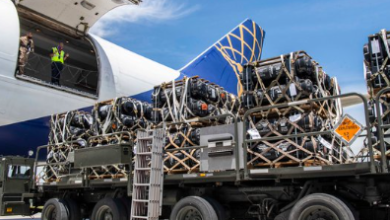Medal of Honor Monday: Navy Lt. Thomas Eadie
Navy Lt. Thomas Eadie spent a combined 30 years of service in the Navy from the early 20th century to after World War II. His work as an expert diver salvaging shipwrecks earned him several accolades, especially when it came to saving a fellow diver who had gotten tangled far below the water. For that rescue, he earned the Medal of Honor.
Eadie was born on April 8, 1887, in Glasgow, Scotland. His parents, William and Rebecca, moved to the U.S. in 1890, settling the family in New Jersey. Eadie had a brother, George, and a sister, Margaret.
Eadie enlisted in the Navy in July 1905 shortly after he’d turned 18. Trained as a gunner’s mate and as a diver, he remained in the service until 1913, when he moved to Newport, Rhode Island. At some point, he married Margaret Gerrie, and they had a daughter named Marion.
Eadie returned to the Navy during World War I, then worked as a civilian diver for a time before returning to the Navy yet again in 1926. By then, he had worked his way up in rank to chief petty officer.
Eadie was credited with helping to salvage two sunken submarines: the USS S-51, which sank off the coast of Rhode Island in 1925, and the USS S-4, which sank off the coast of Provincetown, Massachusetts. Both operations earned him a Navy Cross, but it was the latter that earned him the Medal of Honor.
On Dec. 18, 1927, the Coast Guard received calls that the USS S-4 submarine had been involved in a collision with a Coast Guard destroyer and sank off the coast of Provincetown while undergoing sea trials. Rescue efforts began immediately, although Eadie and a handful of other expert divers weren’t able to arrive at the scene until the next day, thanks in part to bad weather that was thwarting the operation.
A few minutes after Eadie went into the water, he was able to locate the sunken sub. Reports show that when he tapped on its torpedo loading hatch to see if anyone had survived, he received six slow taps in reply, indicated six men were still alive. He got no other responses when he tapped on other sections of the hull, so he returned to the surface to report his findings and recuperate from the dive, which is necessary for all divers operating in deep waters. Other divers went down in his place to continue the mission.
That afternoon, another diver, Fred Michels, went down with a hose that they were hoping to connect to the S-4 to deliver the trapped men much-needed fresh air. However, as Michels was attempting to connect the air line to the sub at a depth of 102 feet, his tether became seriously entangled in the wreckage, trapping him.
When the team above water realized what was happening, Eadie quickly volunteered to go back down to help, even though he was still recovering from his first dive.
Eadie finally reached Michels after the trapped diver had been underwater for about an hour and a half. Eadie saw Michels’ line was twisted up in the submarine’s metal, so he requested that a hacksaw be lowered down. Eadie sawed at the wreckage for 45 minutes before he was able to release Michels from the tangle.
After more than two hours of extremely dangerous work, Eadie succeeded in getting Michels back to the surface. Michels was put in the ship’s decompression chamber in serious condition, but he survived thanks to Eadie’s skills and his ability to stay calm under pressure.
Sadly, the crew lost the hose that Michels had carried down to attach to the submarine, so they were never able to get fresh air inside it. All 39 crew members and one civilian observer on the S-4 died. The sub was raised on March 17, 1942, and eventually returned to service before being stricken from the register in 1936.
Eadie was quickly nominated for the Medal of Honor, which he received from President Calvin Coolidge during a White House ceremony on Feb. 23, 1928.
Eadie continued to serve the Navy for another decade before retiring from active duty in 1939; however, he returned yet again in April 1942 during World War II, when he was appointed as a chief gunner (warrant officer). He received a commission in August 1942, then retired for good as a lieutenant in September 1946 after a combined 30 years of service.
From 1941-1942, Eadie was the national commander of the U.S. Legion of Valor. While in London in 1960, he became an honorary member of the British Foreign Legion, according to his obituary in the Newport Mercury newspaper.
Eadie died on Nov. 14, 1964, at age 87 at the Brockton Veterans Affairs Medical Center in Brockton, Massachusetts. He is buried in Island Cemetery in Newport, Rhode Island, where he spent the last few decades of his life.
This article is part of a weekly series called “Medal of Honor Monday,” in which we highlight one of the more than 3,500 Medal of Honor recipients who have earned the U.S. military’s highest medal for valor.
Source: Department of Defense
Content created by Conservative Daily News is available for re-publication without charge under the Creative Commons license. Visit our syndication page for details.




